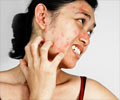- About Fish Allergy - (http://kidshealth.org/en/parents/fish-allergy.html)
- Introduction on Shellfish Allergy - (http://www.ecarf.org/en/information-portal/allergies-overview/shellfish-allergy/)
- American college of allergy, asthma and Immunology - (http://www.acaai.org/)
- Shellfish allergy - (http://www.mayoclinic.org/diseases-conditions/shellfish-allergy/basics/definition/con-20032093)
What are Seafood Allergies?
Seafood allergy is an abnormal response by the body’s immune system to proteins present in certain marine sea animals. Seafood includes both vertebrate finned fish (eg. salmon, tuna, mackerel, sardines and cod) and invertebrate shellfish e.g., crab, shrimp, mussels, clams, octopus, squid and lobster).
Within the shellfish family, the crustacean group (which has jointed legs) such as crayfish, lobster, prawns, shrimp, and crab cause the greatest number of allergic reactions when compared to mollusks (which have a hinged two part shell) such as oysters, octopus, scallops, snails, clams, mussels, and squid or cuttlefish.
Even though both finned fish and shellfish are considered as seafood, they are biologically different. Having a food hypersensitivity to shellfish, does not mean that you are allergic to finned fish as well. It is commonly seen that someone who is allergic to a specific type of fish can safely eat other seafood without any allergic reactions.
What Triggers Seafood Allergy?
Allergens in Seafood: The main allergens which trigger a hypersensitive response against crustaceans and mollusks are called tropomyosins. They are not destroyed by cooking or (heating) and can thus provoke an allergic reaction.
Family history of seafood allergy: If you have a family history of shellfish or other fish allergy the chances of developing of seafood allergy is high.
Age: Seafood allergy can develop at any age. It is seen that some people who have eaten fish in the past can develop an allergy to it at some point in life. In some cases, they people outgrow certain food allergies over time, however, in most cases, of seafood allergies they usually have that allergy persist for the rest of their lives.
What are the Symptoms of Seafood Allergy?
The following signs and symptoms are generally observed in seafood allergies:
- Skin rashes or hives
- Swelling of the lips, throat, face and other parts of the body
- Nausea, vomiting, stomach cramps, indigestion, and diarrhea
- Difficulty in breathing, wheezing, congestion, or asthma
- Lightheaded, dizziness or fainting

In rare cases, severe seafood allergy can cause anaphylaxis, a potentially life-threatening reaction that affects breathing and the person can go into a shock. It is a medical emergency that requires immediate treatment, and if left untreated it, can prove fatal.
Symptoms of anaphylactic shock include facial swelling, swollen throat or a lump in your throat (airway constriction), breathing difficulty, increased pulse rate, loss of consciousness, and shock, with severe drop in blood pressure.
How do you Diagnose Seafood Allergy?
Consult a doctor if you experience any of the above mentioned symptoms shortly after consuming any seafood. Your doctor or allergist will take a complete history of your symptoms and may perform a physical examination to rule out other medical condition. A skin test and blood test will be ordered to confirm the diagnosis.
Skin prick test: In this test, your skin is pricked and exposed to small amounts of the proteins found in seafood that you are allergic to. If any inflammation or reaction occurs, the patient is diagnosed to be positive for seafood allergy.
Blood test: Blood is tested for the presence of allergen-specific immunoglobulin E (IgE) antibodies to a specific protein from the fish being tested.
A history of an allergic reaction shortly after consumption of any fish can be a sign of a seafood allergy. However, skin and blood tests are the best methods to confirm the symptoms and to rule out other conditions such as food poisoning.

What are Seafood Allergy Management and Treatment Methods?
Managing any food hypersensitivity includes strict avoidance of the food to which you are allergic. Usually, doctors advise patients with seafood allergy to avoid all types of seafood. However, if you are allergic to a specific fish and wish to consume other seafood, speak to your doctor about allergic tests for other types of fish.
Treatment of an acute reaction includes prescription of an antihistamine, which will help to reduce skin rashes, swellings, and hives. However, if the patient goes into anaphylaxis, they need emergency medical care and immediate treatment with a drug called epinephrine. If you have a tendency for anaphylaxis then your doctor might recommend you to carry injectable epinephrine with you at always and administer epinephrine even. This should be administered at the onset of the first sign of an allergic reaction as a preventive measure.

How to Manage Shellfish Allergies in Children?
If your child is allergic to seafood, the best way to prevent it, is strict avoidance of all types of seafood (until the specific fish is identified). Parents must be very cautious while taking their children to dine out. When purchasing packed food, check labels in detail for any seafood ingredients and preferably stay away from places where seafood is prepared or processed.
- Avoid known triggers: Even if you are under treatment for your allergy and symptoms are under control, try to avoid other known triggers. For instance, avoid eating at restaurants where seafood is prepared or processed, check labels for contents before buying any edible product, and do not share plates with people who are consuming seafood to avoid cross contact.
- Keep a diary: An important part of the allergic treatment is the patient being cooperative and helping the doctor to identify the allergen. The best way to identify the exact allergen is by noting down all the abnormal symptoms after consuming any product.
- Wear a medical alert bracelet or necklace: If you are a known patient of severe allergic reaction to a particular seafood, wear a medical alert bracelet or necklace that will let others know of the serious allergy in case you accidentally consume a product and develop a severe reaction and where you are unable to communicate.
- Avoid indirect exposure to allergens: Many of the allergenic proteins in seafood are stabilized, vaporized, or released during cooking. However, in rare cases, respiratory reactions may occur from airborne exposure that can occur by being near the area when fish is cooked fish or even in a fish market.







